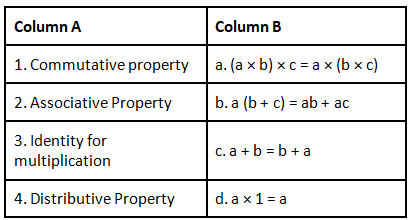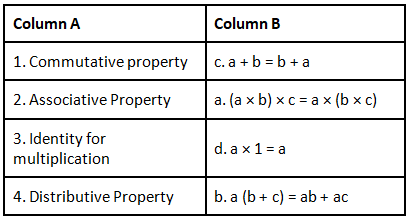Class 6 Maths Chapter 2 Important Question Answers - Whole Numbers
Q1: If you’re on a diet and have a breakfast consisting of 150 calories, a lunch consisting of 350 calories, and a dinner consisting of 1000 calories, then find the sum of the calories consumed that day.
Ans: Breakfast consisting of 150 calories.
Lunch consisting of 350 calories.
Dinner consisting of 1000 calories.
The sum of the calories consumed that day is 150 + 350 + 1000 = 1500 calories.
Q2: A taxi driver filled his car petrol tank with 40 litres of petrol on Monday. The next day, he filled the tank with 50 litres of petrol. If the petrol costs Rs.44 per litre, how much did he spend in all on petrol?
Ans: Petrol filled on Monday = 40 litres.
Petrol filled the next day = 50 litres.
∴ Total petrol filled on the two days = 40 litres + 50 litres = 90 litres.
∴ Cost of petrol per litre = Rs.44
∴ Cost of 90 litres petrol = Rs.44 × 90 = Rs.3960.
Ans:
Largest 6 digit number = 999,999Smallest 7 digit number = 1,000,000
Thus, the smallest 7 digit number is larger than the largest 6 digit number.
Again,
Difference between these two numbers = 1,000,000 – 999,999 = 1
Hence, the smallest seven-digit number is larger than the largest six-digit number by 1.
Q4: Find the product of the greatest three-digit number and the greatest two-digit number.Ans: Greatest three-digit number = 999
Greatest two-digit number = 99
∴ Product of both numbers = 999 x 99 = 999 x (100 – 1)
= 999 x 100 – 999 x 1
= 99900 – 999 = 98901
Q5: A housing complex built by DLF consists of 25 large buildings and 40 small buildings. Each of the large buildings has 15 floors with four apartments on each floor, and each small building has nine floors with three apartments on each floor. How many apartments are there in total?Ans: Number of the large buildings = 25
Number of the floors = 15
Number of the apartments on each floor = 4
∴ Total number of the apartments in large buildings = 25 x 15 x 4
Number of small buildings = 40
Number of the floors = 9
Number of the apartments on each floor = 3
∴ Total number of the apartments in small buildings = 40 x 9 x 3
Hence, the number of apartments in total = 25 x 15 x 4 + 40 x 9 x 3 = 1500 + 1080 = 2580.
Q6: A school principal placed orders for 85 chairs and 25 tables with a dealer. Each chair costs ₹180, and each table costs ₹140. If the principal has given ₹2500 to the dealer as an advance money, what amount is to be given to the dealer now?Ans: Number of total chairs = 85
Cost of one chair = ₹ 180
Cost of 85 chairs = ₹ (85 x 180)
Number of total tables = 25
Cost of one table = ₹ 140
Cost of 25 tables = ₹ (25 x 140)
Total amount of all chairs and tables = ₹(85 x 180 + 25 x 140)
= ₹ (15300 + 3500) = ₹ 18800
Money given in advance by principal = ₹ 2500
∴ Remaining money to be paid to the dealer = ₹ 18800 – ₹ 2500 = ₹ 16300
Q7: A dealer purchased 124 LED sets. If the cost of one set is ₹38,540, determine their total cost.Ans: Total cost of 124 LED sets = ₹(38,540 x 124)
= ₹ [38,540 x (100 + 20 + 4)]
= ₹ [38,540 x 100 + 38,540 x 20 + 38,540 x 4]
= ₹ [38,54,000 + 7,70,800 + 1,54,160]
= ₹ 47,789,60
Q8: Find the product by suitable rearrangement:
(a) 8 × 391 × 125
(b) 2 × 1234 × 50
Ans: (a) 8 × 391 × 125 = 391× (125 × 8)
= 391 × 1000
= 391,000
(b) 2 × 1234 × 50 =1234 × (2 × 50)
= 1234 × 100
= 123,400
Q9: State true or false:
(a) All natural numbers are whole numbers.
(b) All whole numbers are natural numbers.
(c) The predecessor of a two digit number is never a single digit number.
(d) 1 is the smallest whole number.
Ans: (a) True
(b) False, every whole number except 0 is a natural number.
(c) False, the predecessor of 10 is 9.
(d) True
Q10: Match the following:
 Ans:
Ans:
Q11: Study the pattern:
1 × 8 + 1 = 9
12 × 8 + 2 = 98
Ans: 1 × 8 + 1 = 9
12 × 8 + 2 = 98
123 × 8 + 3 = 987
As the digit of the 1st number incresing gradually like 1, 12, 123 and the last digit of equation is also increasing like 1, 2, 3 so next pattern will be 123 ×
8 + 3 = 987
And the sum is also in decreasing order like 9, 98, 987
So the next pattern is 123 × 8 + 3 = 987
Q12: Ramesh ordered 10 cartons of chocolates to distribute among the class. Each carton holds 20 boxes and each box has 12 chocolates. How many chocolates did Ramesh order altogether?
Ans: Total Chocolates Ordered by Ramesh:
Number of cartons: 10
Number of boxes per carton: 20
Number of chocolates per box: 12
Total chocolates = 10 cartons × 20 boxes/carton × 12 chocolates/box = 10 × 20 × 12 = 2400
Ramesh ordered 2400 chocolates altogether.
Q13: Mukesh lives in a hostel that charges Rs 55 for dinner and Rs 45 for lunch. Find the money he has to pay for seven days.
Ans: Total Money Mukesh Has to Pay for Meals in Seven Days:
Cost of dinner per day: Rs 55
Cost of lunch per day: Rs 45
Total cost per day = Rs 55 + Rs 45 = Rs 100
Total cost for seven days = 7 days × Rs 100/day = Rs 700
Mukesh has to pay Rs 700 for meals in seven days.
Q14: A taxi driver filled his car petrol tank with 40 litres of petrol on Monday. The next day, he filled the tank with 50 litres of petrol. If the petrol costs Rs 44 per litre, how much did he spend in all on petrol?
Ans: Total Money Spent on Petrol by Taxi Driver:
Petrol on Monday: 40 litres
Petrol on Tuesday: 50 litres
Cost per litre: Rs 44
Total litres of petrol = 40 + 50 = 90 litres
Total cost = 90 litres × Rs 44/litre = Rs 3,960
The taxi driver spent Rs 3,960 on petrol.
Q15: A vendor supplies 32 litres of milk to a hotel in the morning and 68 litres of milk in the evening. If the milk costs Rs 15 per litre, how much money is due to the vendor per day?
Ans: Money Due to the Milk Vendor per Day:
Milk supplied in the morning: 32 litres
Milk supplied in the evening: 68 litres
Cost per litre: Rs 15
Total milk supplied per day = 32 + 68 = 100 litres
Total cost per day = 100 litres × Rs 15/litre = Rs 1,500
The money due to the vendor per day is Rs 1,500.
Q16: A person had Rs 1000000 with him. He purchased a colour T.V. for Rs 16580, a motor cycle for Rs 45890 and a flat for Rs 870000. How much money was left with him?
Ans: Money Left with the Person after Purchases:
Initial amount: Rs 1,000,000
Cost of T.V.: Rs 16,580
Cost of motorcycle: Rs 45,890
Cost of flat: Rs 870,000
Total spent = Rs 16,580 + Rs 45,890 + Rs 870,000 = Rs 932,470
Remaining amount = Rs 1,000,000 - Rs 932,470 = Rs 67,530
The money left with him is Rs 67,530.
Q17: Chinmay had Rs 610000. He gave Rs 87500 to Jyoti, Rs 126380 to Javed and Rs 350000 to John. How much money was left with him?
Ans: Money Left with Chinmay after Giving Away Money:
Initial amount: Rs 610,000
Amount given to Jyoti: Rs 87,500
Amount given to Javed: Rs 126,380
Amount given to John: Rs 350,000
Total given away = Rs 87,500 + Rs 126,380 + Rs 350,000 = Rs 563,880
Remaining amount = Rs 610,000 - Rs 563,880 = Rs 46,120
The money left with Chinmay is Rs 46,120.
Q18: Find the sum of the greatest and the least six digit numbers formed by the digits 2, 0, 4, 7, 6, 5 using each digit only once.
Ans: Sum of the Greatest and Least Six-Digit Numbers Formed by the Digits 2, 0, 4, 7, 6, 5:
Greatest number: 765420
Least number: 204567
Sum of greatest and least numbers = 765,420 + 204,567 = 969,987
The sum of the greatest and least six-digit numbers formed by the digits 2, 0, 4, 7, 6, and 5 is 969,987.
|
147 videos|222 docs|54 tests
|
FAQs on Class 6 Maths Chapter 2 Important Question Answers - Whole Numbers
| 1. What are whole numbers? |  |
| 2. Can whole numbers be negative? |  |
| 3. How are whole numbers used in real-life situations? |  |
| 4. What is the difference between whole numbers and natural numbers? |  |
| 5. How can whole numbers be represented on a number line? |  |
















